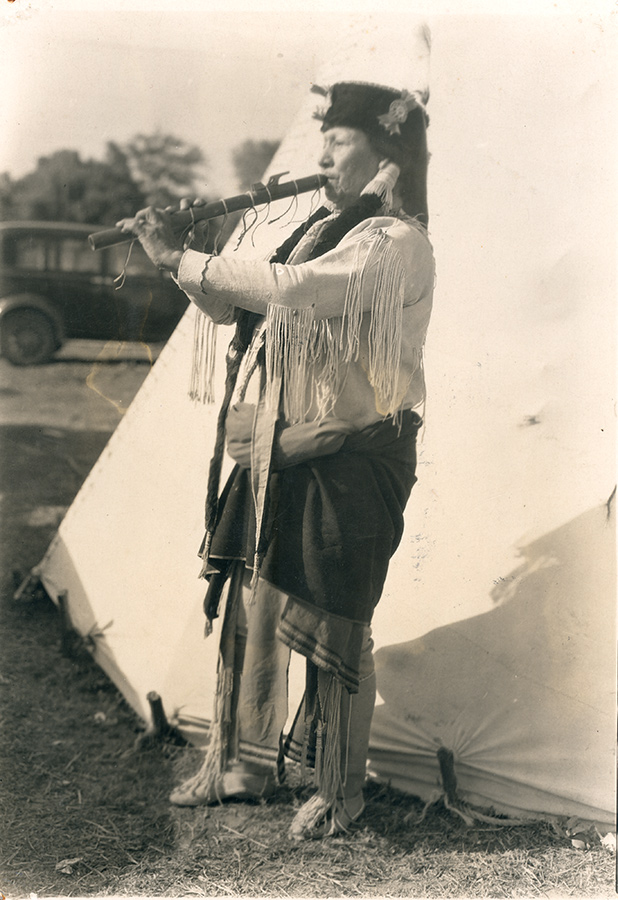
The Encyclopedia of Oklahoma History and Culture
MUSIC, AMERICAN INDIAN.
Powwows, hand games, churches, and stomp dances are only a few places and events where American Indian music comes alive in Oklahoma. Here, as in many states with large Indian populations, music is both incredibly diverse and incredibly important for the maintenance of local traditions. Music permeates almost every aspect of Oklahoma's Native cultures and is constantly shaping and reshaping Native life.
Most Oklahoma Indian musical traditions are vocal song traditions. These range from private, family-oriented traditions (such as lullabies and other children's songs), to church and ceremonial songs (such as Protestant Indian hymns and Native American Church peyote songs), to broadly public song traditions (such as hand game and powwow songs). At times these song traditions are accompanied by instruments like drums (such as the those used at powwows), rattles (such as the gourd rattles used in the Native American Church), or turtle shell leg rattles (such as the "turtle shackles" used at stomp dances in eastern Oklahoma). In addition to these, other traditional instruments (used apart from vocal song traditions) include the Plains Indian courting flute and the Fort Sill Apache violin.
Many of these song traditions are intertribal and are exchanged between and among many Native communities in Oklahoma. Exemplary are the Native American Church peyote songs and the intertribal powwow songs. Other song traditions are widespread, such as Protestant Indian hymns, and obviously share a common history, yet they are distinguished from one another by their particular pasts, innovations, sound, and (perhaps most importantly) their differences in language content. Exemplary is the contrast between Cherokee and Comanche hymns. In addition to this, certain song traditions dominate in certain parts of the state. For example, in eastern Oklahoma, where tribes originally hailed from the southeastern United States, the stomp dance, which was originally associated with many of the Eastern tribes, and its songs maintain a high level of visibility.
The powwow, which is Plains Indian in its origin, often takes a secondary role in these communities. Conversely, in western Oklahoma, where many tribes originally hailed from the southern plains, the powwow and its songs takes precedence over the stomp dance, which, not surprisingly, often takes a secondary role.
It is important to realize that all human music is in a constant state of flux and change. American Indian music, like all music, participates in this process. Newer Oklahoma traditions include the composition of traditional songs with English lyrics (such as in the Oklahoma "two-step" performed at powwows all over the state), the improvisation and merging of Indian themes with American popular music (such as that presented by Anadarko's blues group, "Blues Nation"), and all-Indian fiddle contests (such as the event held each year in Tahlequah).
Given this, however, many in Oklahoma's Native America often consider musical traditions with historical antecedents among the most vital expressions for maintaining tribal culture, second only to language. Traditional music is not just musical "sound," it is a powerful way to engage and reengage tribal heritage and memory. As a medium for the oral transmission of history, as a means of celebration, and as a spiritual exercise, music, like language, gives a people its identity. With this in mind, in the late twentieth century many elderly song leaders turned their attention toward preserving song for future generations. While song and its purposes are always changing, with new songs regularly being composed within long-established traditional genres, for many of these song leaders the preservation work has come to comprise a significant part of the life of traditional American Indian music in Oklahoma.
Importantly, Native song leaders thus contend that their preservation work is not just about sustaining the music itself. It is a means of maintaining a unique and rich cultural heritage. In turn, preservation continually helps to forge the larger and ever-diverse "soundscape" of Oklahoma.






